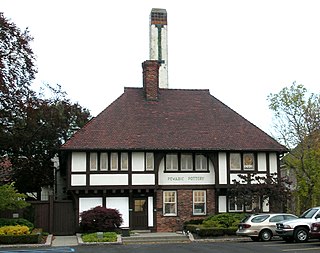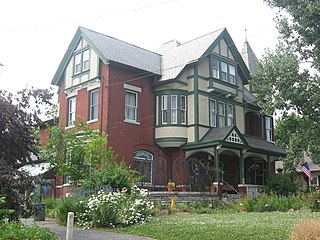
Pewabic Pottery is a ceramic studio and school in Detroit, Michigan. Founded in 1903, the studio is known for its iridescent glazes, some of which grace notable buildings such as the Shedd Aquarium and Basilica of the National Shrine of the Immaculate Conception. The pottery continues in operation today, and was designated a National Historic Landmark in 1991.

The Mercer Museum is a museum located in Doylestown, Pennsylvania. The Bucks County Historical Society operates the Mercer Museum, as well as the Research Library, and Fonthill Castle, former home of the museum's founder, archeologist Henry Chapman Mercer.

Fonthill, also known as Fonthill Castle, was the home of the American archeologist and tile maker Henry Chapman Mercer, in Doylestown, Pennsylvania.

The Moravian Pottery & Tile Works (MPTW) is a history museum which is located in Doylestown, Pennsylvania. It is owned by the County of Bucks, and operated by TileWorks of Bucks County, a 501c3 non-profit organization.

Azulejo is a form of Spanish and Portuguese painted tin-glazed ceramic tilework. Azulejos are found on the interior and exterior of churches, palaces, ordinary houses, schools, and nowadays, restaurants, bars and even railways or subway stations. They are an ornamental art form, but also had a specific functional capacity like temperature control in homes.

Manises is a municipality in the comarca of Horta Oest in the Valencian Community, Spain. Located in the province of Valencia, it had 30,693 inhabitants in 2018 (NSI) and is famous for its pottery and being the location of Valencia Airport.

The George Scott House is a historic residence in Cincinnati, Ohio, United States. Built in the 1880s according to a design by prominent architect Samuel Hannaford, it was originally home to a prosperous businessman, and it has been named a historic site.

The Campana Factory is a historic building in Batavia, Illinois. It was built in 1936 to serve as a factory for The Campana Company, which produced Italian Balm, the most popular hand lotion in the United States during The Great Depression. The Streamline Moderne and Bauhaus building features many innovative technologies, such as air conditioning. It was added to the National Register of Historic Places in 1979.

The Women's City Club is a women's club located at 2110 Park Avenue in Downtown Detroit, Michigan, within the Park Avenue Historic District. It was listed on the National Register of Historic Places and designated a Michigan State Historic Site in 1979.

The Santa Fe Apartments were an apartment building located in Detroit, Michigan. The building was listed on the National Register of Historic Places in 1986 and subsequently demolished by Wayne State University and removed from the National Register of Historic Places in 2022. The site is now the location of the Yousif B. Ghafari Hall.

Morganville Pottery Factory Site is an archeological site located at Morganville in Genesee County, New York. It was the location of a factory that produced ceramics and tile from 1829 until the end of the 19th century.

La Iglesia Pentecostal La Luz del Mundo / Light of the World Church Pentecostal Church is an Assemblies of God Pentecostal church in Williamsburg, Brooklyn, New York City, located at 179 South 9th Street, occupying the historic 19th-century former New England Congregational Church since 1955.

The William B. and Mary Chase Stratton House is a private house located at 938 Three Mile Dr. in Grosse Pointe Park, Michigan. It was listed on the National Register of Historic Places in 1984.
The Lawson Airplane Company-Continental Faience and Tile Company was a factory complex in South Milwaukee, Wisconsin. It was added to the National Register of Historic Places in 2001 and has since been demolished.

Fonthill, Mercer Museum and Moravian Pottery and Tile Works is a National Historic Landmark District located at Doylestown, Bucks County, Pennsylvania. It consists of three properties built by Henry Chapman Mercer (1856-1930) in a distinctive application of the principles of the Arts and Crafts movement, which are also notable for the early use of poured concrete: Fonthill, the Mercer Museum, and the Moravian Pottery and Tile Works. All three are now museum properties of the Bucks County Historical Society. The landmark designation for the group was made in 1985; each property is also individually listed on the National Register of Historic Places.

The Amory Ballroom is the only surviving remnant of a large summer estate house off Old Troy Road in Dublin, New Hampshire. Built in two stages, it is an architecturally distinctive reminder of the community's early 20th-century period as a summer resort area. The building was listed on the National Register of Historic Places in 1985.

The Bonaparte Pottery Archeological District is a nationally recognized historic district located in Bonaparte, Iowa, United States. It was listed on the National Register of Historic Places in 1999. At the time of its nomination it contained four resources, which included one contributing building, one contributing site, and two non-contributing buildings. The contributing resources include the remains of two kilns from Bonaparte Pottery, which operated from 1866 to 1895. It also includes the factory building (1876) that replaced a building that was destroyed in a fire in November 1875. The non-contributing resources include two buildings that are associated with the lumberyard that took over the site after the pottery closed. They were built after the period of historical significance.
John Glaser Pottery Factory, also known as the Archibald S. Bryan Building, was a historic pottery factory building located at Washington, Franklin County, Missouri. It was built about 1879, and expanded about 1890. It was a one-story with basement, heavy timber frame building in the Fachwerk form. It was set into a hillside and located close to the river and the railroad tracks. The factory operated until about 1901 and later converted to residential use.

The Logia Masónica Hijos de la Luz, on Avenida José C. Barbosa in Yauco, Puerto Rico, is a stuccoed masonry building constructed in 1894. It was listed on the National Register of Historic Places in 1988.
The Julius and Sophia Norton House is a historic house at 300 Pleasant Street in Bennington, Vermont. Its main block, completed in 1846, is one of the state's finest examples of Greek Revival architecture. It was listed on the National Register of Historic Places in 2021.


















